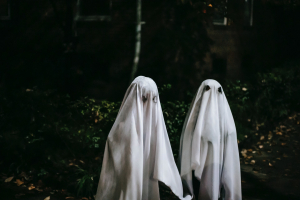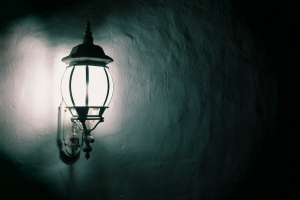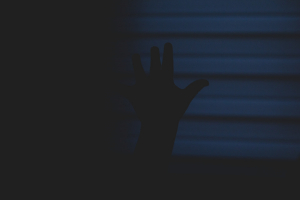There are few things in this world as frightening as a terrified child in the middle of the night. If your child is experiencing night terrors, you are not alone. An estimated 30% of children between the ages of three- and seven-years-old experience the phenomenon. But what causes night terrors? What is the difference between these scary episodes and nightmares?
The Difference Between Dreams and Night Terrors
What are night terrors compared to bad dreams or nightmares? Children and adults both experience nightmares at different times during REM sleep which occurs toward the end of the sleep cycle. A child may wake up during a bad dream and recall every detail. Most of the time, the child does not sleepwalk during a nightmare.

Night terrors, on the other hand, are rare in adults. Children typically outgrow them by age 10. These terrors occur during non-REM sleep, meaning the child is not in the vivid dreaming phase. They may sit up in bed, scream, or sleepwalk. Often, a child cannot recall sleep terrors. The details of the night terror are missing or extremely vague.
Although your child’s eyes may be partially open, they are still asleep during a night terror, unlike a nightmare. The emotions they are feeling during this time are extreme terror and panic. This may cause them to thrash about, scream or shout, or try to get away. The episode may last up to 45 minutes, but eventually, your child will settle back into a deep sleep.
Watching your young child during a night terror is scary, but you will need to wait it out until the terror passes and the child drifts back into sleep. Baby night terrors, those that occur under the age of three years, are rare, although night terrors in children as young as one-year-old have been reported.
Causes of Night Terrors
Night terrors occur during the non-REM phase of sleep, typically within 90 minutes or so of falling asleep. Since this is also the phase that sleepwalking can occur, night terrors can sometimes lead to the child getting out of bed.
 Night terrors have been known to run in families, however environmental and internal conditions can cause an episode. A child under a great deal of stress due to relocation, parents’ divorce, or trauma may begin having night terrors. Depression, anxiety, and lack of sleep can also combine, resulting in overwhelming panic during sleep.
Night terrors have been known to run in families, however environmental and internal conditions can cause an episode. A child under a great deal of stress due to relocation, parents’ divorce, or trauma may begin having night terrors. Depression, anxiety, and lack of sleep can also combine, resulting in overwhelming panic during sleep.
Other factors like too much caffeine, side effects from prescription medication that affect your child’s central nervous system, or fever can instigate these childhood terrors. The central nervous system (CNS) oversees your child’s brain activity during the day and regulates sleep at night. Unlike in adults, a child’s CNS is still developing and maturing. This may be why night terrors in kids are more common than in adults.
Is Your Child Having Night Terrors?
Night terror symptoms in children include:
- sitting up in bed during sleep,
- shouting or screaming,
- sleepwalking or thrashing,
- profusely sweating,
- eyes partially open or wide open but the child is still asleep,
- abnormal or rapid breathing,
- inconsolable crying,
- doesn’t recognize parents or guardians or can’t “see” them,
- episodes begin shortly after sleep begins and lasts less than 45 minutes,
- drifts back into a deep sleep with little recall of the night terror.
Children with night terrors may be tired the next day or have trouble concentrating in school. They become anxious or embarrassed if others make fun of them for their behavior during a night terror. Children are at a very vulnerable age and they need to feel that they can turn to a trusted adult.
Infants who experience night terrors have similar symptoms but maybe overly tired the next day and abnormally fussy. Educate any caregivers for your baby about what to do if they suspect the infant is having a sleep terror. Remind them not to force the baby awake during a sleep terror episode, but to allow it to play out.
Treating Children for Night Terrors

Night terror episodes may appear only once or several times during a child’s life. Most of the time, the parent can help their child at home without calling for professional help. In extreme cases, if the sleep disturbance persists, the parent will need to seek night terrors treatment from a licensed mental health care professional.
In-Home Treatment
Babies respond well to routines. Try to have a consistent bedtime routine, so your infant doesn’t become overly tired. It’s easy to stay up late while on vacation, but an infant who has sleep terrors should be kept on a schedule to reduce the chances of an episode reoccurring.
If your baby is in the middle of a sleep disturbance, try to hold and comfort them. You may need to make sure that the baby’s head doesn’t hit the sides of the crib during the night terror. Although you are trying to console your baby, don’t wake them. It is easier for an infant to resume sleep after a night terror if they haven’t been fully awakened.
Toddlers, preschoolers, and elementary-aged children will need more safety monitoring during a night terror. It’s easier for the older children to sleepwalk and injure themselves. Common injuries during a night terror include falling down the stairs, tripping over objects, bruising or cutting themselves from thrashing or banging their head on the bed or nightstand. If necessary, remove anything from your child’s room that they could hurt themselves during an episode.
Children, just like adults, experience stress and anxiety. Try to reduce any stressful factors in your child’s life. This could mean reducing the number of extracurricular activities or removing negative influences in their life. Set up a consistent schedule for a bedtime routine and a sleep schedule. You will need to make sure that your child adheres to the schedule during weekends and vacations as well as during the week. This routine will ensure that your child isn’t sleep deprived.
If your child’s night terrors increase, begin keeping a sleep journal. Note the time that these episodes usually begin and how long they last. If the sleep terrors persist, try waking your child before the night terror is expected to begin and keep your child awake for a little while. You may have to repeat this process several nights in a row. This interruption in their sleep cycle might be enough to eliminate the night terrors without seeing a professional.
Professional Treatment
If your child’s night terrors increase in frequency or duration, seek help from a health care professional. Your pediatrician can refer you to a sleep specialist or a therapist depending on the underlying issue for the terrors. If the therapist believes your child’s sleep disturbances are due to stress, anxiety, or depression, then they may recommend psychotherapy to minimize the symptoms. This treatment could consist of talk therapy, play and art therapy, and Cognitive Behavioral Therapy techniques.
 Sometimes night terrors are brought on by sleep apnea or other sleep disorders. A specialist may suggest a sleep study for your child where they will spend the night in a sleep clinic. During this overnight stay, specialists will monitor your child’s breathing, sleep patterns, oxygen levels, and heart rate.
Sometimes night terrors are brought on by sleep apnea or other sleep disorders. A specialist may suggest a sleep study for your child where they will spend the night in a sleep clinic. During this overnight stay, specialists will monitor your child’s breathing, sleep patterns, oxygen levels, and heart rate.
If your child is suffering from an underlying condition that is causing the night terrors such as sleep apnea, narcolepsy, or restless leg syndrome, then your child’s physician will focus on treating the disorder. The doctor may also order tests like an EEG to rule out any additional conditions.
Since night terrors are something children frequently outgrow, the physician will treat any underlying conditions, but not the night terrors themselves. Although a doctor may prescribe medications for other conditions like anxiety or depression, rarely do they prescribe medications for sleep terrors.
Night terrors are scary, but you can help your child through this difficult time. Reassure your toddler or preschooler that you are there for them. Make sure your child knows that they are safe with you and that the night terrors shall soon pass.
Photos:
“Ghosts”, Courtesy of Charles Parker, Pexels.com, CC0 License; “Full Moon”, Courtesy of andrefeo, Pixabay.com, CC0 License; “Wall Lamp”, Courtesy of FredyVCP, Pixabay.com, CC0 License; “Dark Hand”, Courtesy of Alvaro Reyes, Unsplash.com, CC0 License








